The automotive sales industry is a dynamic and ever-evolving sector of the global economy. With an estimated 1.4 billion motor vehicles on the road worldwide, there is a continuous demand for new and used cars.
Whether you’re a car dealership, a salesperson, or someone interested in buying a car, understanding the automotive sales industry and the tactics that drive it can be valuable.
In this blog, we will explore the meaning of the automotive sales industry and delve into some of the most effective tactics that make it thrive.
Let’s Start!!
Understanding the Automotive Industry
The automotive sales industry encompasses all the businesses and individuals involved in selling automobiles, from car manufacturers and dealerships to independent sellers.
Every sales related to vehicles comes under the automotive industry. This industry includes both new and used vehicles, and it plays a crucial role in the global economy.
Automotive Sales Meaning
The term “Automotive” refers to ‘anything related to vehicles’ and the “Sales” is meant to be selling something.
That means the definition of Automotive Sales says, “Automotive sales refer to the showing, purchasing, or leasing of brand-new or pre-owned automobiles or trailers that are in drivable condition and do not require maintenance.”
In very simple terms we can say that Automotive sales is the process of selling vehicles, such as cars, trucks, motorcycles, and other automobiles. This process typically involves dealerships, salespeople, and customers.
Automotive sales can encompass both new and used vehicles and often includes various services like financing, trade-ins, and warranties.
Automotive Sales Aspects
Here are some key aspects of automotive sales:
New Vehicle Sale
This involves selling brand-new vehicles that have never been owned or driven before. Customers can choose from the latest models, and salespeople often provide information about the features and options available.
Used Vehicle Sales
In this case, dealerships or individuals sell pre-owned vehicles. Used vehicle sales can offer cost savings compared to new cars and typically involve evaluating the condition of the vehicle and its history.
Financing
Many customers require financing to purchase a vehicle. Automotive sales often include helping customers secure loans or leases, either through the dealership or external financing institutions.
Trade-Ins
Customers may trade in their existing vehicles when buying a new one. The dealership assesses the value of the trade-in and deducts it from the cost of the new vehicle.
Warranties and After-Sales Services
Dealerships may offer warranties and maintenance services for the vehicles they sell, ensuring that customers have access to repairs and service after the sale.
Customer Support and Information
Salespeople play a crucial role in providing information, answering questions, and guiding customers through the buying process.
Negotiation
Negotiation often occurs during the sales process, as customers try to get the best deal on the vehicle’s price and financing terms.
Test Drives
Customers usually have the opportunity to test drive vehicles to experience their performance and features before making a purchase decision.
Paperwork and Documentation
The sale of a vehicle involves a significant amount of paperwork, including the contract, title transfer, and other legal documents.
Regulations and Compliance
Automotive sales are subject to various local, state, and federal regulations to protect consumers and ensure fair business practices.
Overall, automotive sales is a complex and dynamic industry that involves various players and services aimed at helping customers find the right vehicle that suits their needs and preferences.
In the next section, Let’s understand the most important components of the Automotive Sales Industry.
Key Components of Automotive Sales Industry
Let’s break down some of the key components and players in this industry:
Car Manufacturers
These are the companies responsible for designing, engineering, and producing vehicles. They typically sell their products to dealerships or distributors.
Dealerships
Car dealerships are the primary retail outlets for new and used vehicles. They offer a wide range of cars and often provide maintenance and repair services.
Independent Sellers
Some individuals or small businesses specialize in selling used cars independently. They may purchase vehicles at auctions, from private sellers, or through trade-ins.
Online Marketplaces
The rise of the internet has given birth to various online platforms and marketplaces where both dealerships and private sellers can list their vehicles for sale.
Salespeople
Salespeople are at the forefront of the industry, responsible for assisting customers in choosing the right vehicle and closing deals.
Now, we are going to delve into Auto Sales Industry Growth, after that we will know more about Auto Industry Trends in 2023.
Auto Sales Industry Growth (2022-23)
We are going to understand the Auto Sales Industry by considering three major factors: Production, Domestic Sales, and Export.
Production
In April 2022 to March 2023, the industry produced 2,59,31,867 vehicles, including passenger cars, commercial vehicles, three-wheelers, two-wheelers, and quadricycles, compared to 2,30,40,066 units in April 2021 to March 2022.
| Category | 2017-18 | 2018-19 | 2019-20 | 2020-21 | 2021-22 | 2022-23 |
|---|---|---|---|---|---|---|
| Passenger Vehicles | 4,020,267 | 4,028,471 | 3,424,564 | 30,62,280 | 36,50,698 | 45,78,639 |
| Commercial Vehicles | 895,448 | 1,112,405 | 756,725 | 6,24,939 | 8,05,527 | 10,35,626 |
| Three Wheelers | 1022,181 | 1,268,833 | 1,132,982 | 6,14,613 | 7,58,669 | 8,55,696 |
| Two Wheelers | 23,154,838 | 24,499,777 | 21,032,927 | 18,349,941 | 1,78,21,111 | 1,94,59,009 |
| Quadricycles | 1,713 | 5,388 | 6,095 | 3,836 | 4,061 | 2,897 |
| Grand Total | 2,90,94,447 | 3,09,14,874 | 2,63,53,293 | 2,26,55,609 | 2,30,40,066 | 2,59,31,867 |
Domestic Sales
The total number of passenger vehicles sold rose from 30,69,523 to 38,90,114. In comparison to the prior year, sales of passenger cars grew from 14,67,039 to 17,47,376, utility vehicles from 14,89,219 to 20,03,718, and vans from 1,13,265 to 1,39,020 units in FY-2022–2023.
The total number of sales of commercial vehicles rose from 7,16,566 to 9,62,468 units. In comparison to the prior year, sales of Light Commercial Vehicles climbed from 4,75,989 to 6,03,465 units, while Sales of Medium and Heavy Commercial Vehicles increased from 2,40,577 to 3,59,003 units in FY-2022–2023.
In comparison to the prior year, sales of three-wheelers grew to 4,88,768 units in FY-2022–2023.
Sales of two-wheelers grew in FY-2022–2023 from 1,35,70,008 to 1,58,62,087 units over the prior year.
| Category | 2017-18 | 2018-19 | 2019-20 | 2020-21 | 2021-22 | 2022-23 |
| Passenger Vehicles | 32,88,581 | 33,77,389 | 27,73,519 | 27,11,457 | 30,69,523 | 38,90,114 |
| Commercial Vehicles | 8,56,916 | 10,07,311 | 7,17,593 | 5,68,559 | 7,16,566 | 9,62,468 |
| Three Wheelers | 6,35,698 | 7,01,005 | 6,37,065 | 2,19,446 | 2,61,385 | 4,88,768 |
| Two Wheelers | 2,02,00,117 | 2,11,79,847 | 1,74,16,432 | 1,51,20,783 | 1,35,70,008 | 1,58,62,087 |
| Quadricycles | 0 | 627 | 942 | -12 | 124 | 725 |
| Grand Total | 2,49,81,312 | 2,62,66,179 | 2,15,45,551 | 1,86,20,233 | 1,76,17,606 | 2,12,04,162 |
Export
Passenger vehicle exports rose from 5,77,875 to 6,62,891 units between April 2022 and March 2023, while commercial vehicle exports fell from 92,297 to 78,645.
During the same period last year, two-wheeler exports fell from 44,43,131 to 36,52,122 units, and three-wheeler exports fell from 4,99,730 to 3,65,549 units.
| Category | 2017-18 | 2018-19 | 2019-20 | 2020-21 | 2021-22 | 2022-23 |
| Passenger Vehicles | 7,48,366 | 6,76,192 | 6,62,118 | 4,04,397 | 5,77,875 | 6,62,891 |
| Commercial Vehicles | 96,865 | 99,933 | 60,379 | 50,334 | 92,297 | 78,645 |
| Three Wheelers | 3,81,002 | 5,67,683 | 5,01,651 | 3,93,001 | 4,99,730 | 3,65,549 |
| Two Wheelers | 28,15,003 | 32,80,841 | 35,19,405 | 32,82,786 | 44,43,131 | 36,52,122 |
| Quadricycles | 1,605 | 4,400 | 5,185 | 3,529 | 4,326 | 2,280 |
| Grand Total | 40,42,841 | 46,29,049 | 47,48,738 | 41,34,047 | 56,17,359 | 47,61,487 |
Now, we will explore the most important Auto Industry Trends of 2023.
7 Essential Auto Industry Trends (2023-2025)
1. Electric Vehicle: Highly Adopted Across The World
In this ever evolving world, the Automotive Industry is experiencing the conversion of car consumers into electric vehicles (EVs) across the globe.
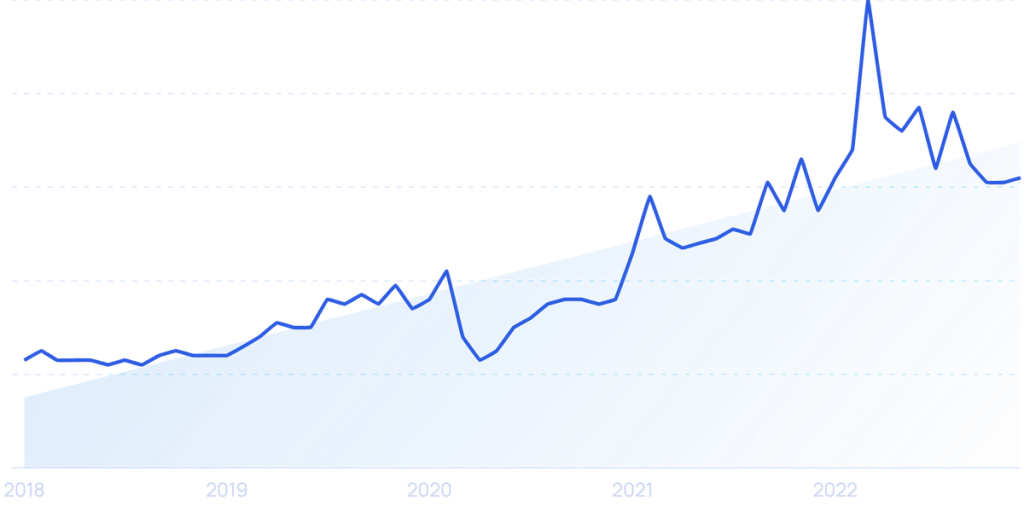
EV searches
Over the last five years, there has been a 169% increase in searches for “electric vehicles.”
Global EV sales are predicted by the IEA to surpass 3 million units in 2020. That is more than 4% of all car sales worldwide.
In terms of EV sales, 2020 exceeded forecasts, increasing by more than 40% from the previous year, following a dismal 2019 performance.
It is estimated that there are currently more than 10 million electric vehicles on the road as a result of this growth.
China and Europe have been setting the pace for the growth in EV sales over the last five years.
According to New Energy Finance, by 2025 EV sales will make up 10% of all new car sales, and by 2040, 58%.
By 2030, the percentage of EV-powered vehicles on the road is predicted to stay at just 8%, despite this explosive growth.
The global vehicle fleet is expected to undergo a massive rotation in the 2030s.
It is anticipated that more than 30% of vehicles on the road will be electric vehicles by the end of that decade.
The needs of the regulations will propel a large portion of this growth.
By 2050, a number of nations hope to have zero net emissions.
2. Autonomous Vehicles: Revolution In Auto Industry
AVs or Autonomous vehicles, are going to change the automotive landscape.
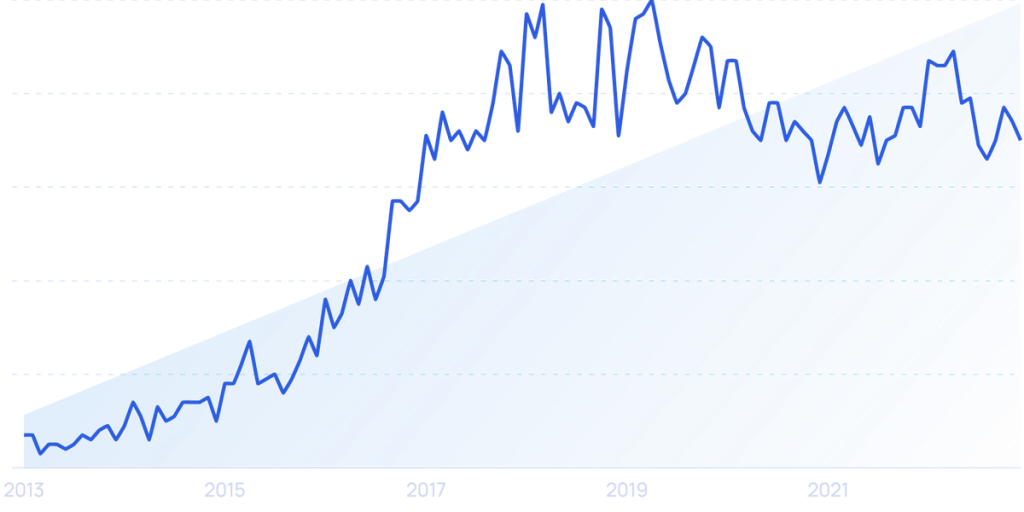
Autonomous Driving Searches
Over the previous ten years, searches for “autonomous driving” have increased by 900%.
As there are currently only 1,400 self-driving cars on the road in the US, the autonomous vehicle (AV) industry is still relatively young.
Nonetheless, it’s predicted that by 2040, there will be 33 million autonomous cars on the road.
The progression of vehicle automation stages is outlined in the “Levels of Driving Automation” standard published by the Society of Automotive Engineers (SAE).
SAE Level 0 (no automation) to SAE Level 5 (full automation) are the ranges of standards.
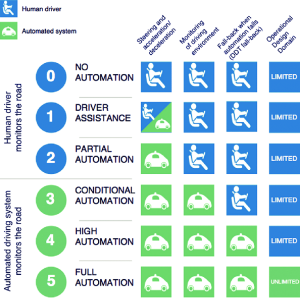
Currently, more than 30 million automobiles that adhere to Level 1 standards are driven.
Additionally, projections show that by 2024, this number will increase to 54.2 million.
Furthermore, by 2024, it is anticipated that over half of all vehicles will fit into the Level 1–5 category.
The current valuation of the global autonomous vehicle market is $54 billion.
And during the following four to six years, it is predicted to grow by about ten times.
Prominent automakers have ventured into the autonomous vehicle market, including Tesla, Alphabet, Ford, GM, and Volvo.
3. Connected Car: Highly Demanded Feature
Cars are getting more and more connected as 5G and the internet of things (IoT) expand.
The rise of the connected car is a result of this.
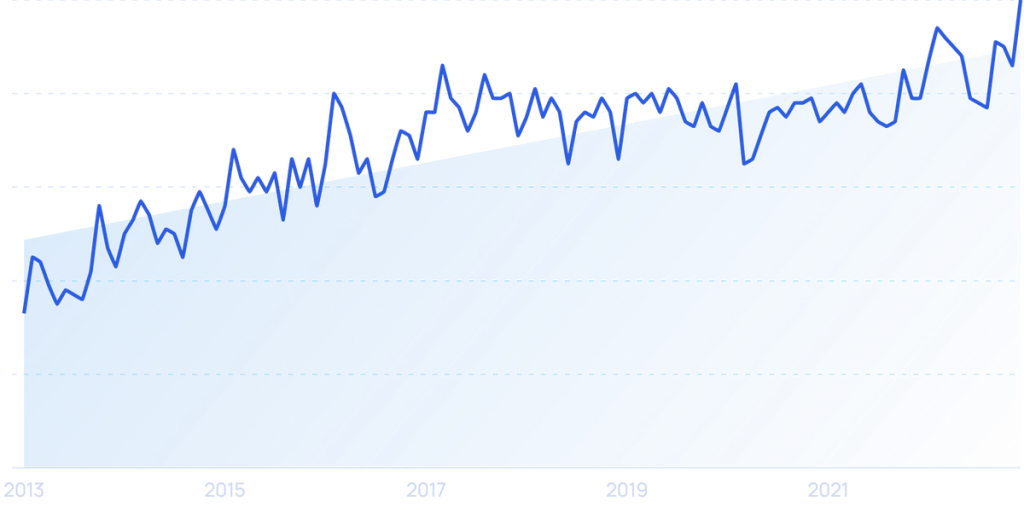
Connected Car Searches
Over the past ten years, searches for “connected car” have increased by 203%.
This kind of car is identified by its capacity to exchange information with other software programs and gather environmental data.
In 2020, it is projected that 47.5 million connected automobiles will be sold.
And it was projected that figure would increase by 20% in 2021.
Estimated market value for connected cars worldwide in 2023 is $88.42 billion.
And by 2028, it is anticipated to reach $191.83 billion.
4. Vehicle Purchase: Converting To Online
The entire process of purchasing a car is being impacted by the internet.
Before making a purchase, more than 90% of car buyers research online.
Furthermore, an increasing number of sales are happening exclusively online.
Prior to the pandemic, internet sales accounted for 4.2% of all car sales.
As dealers worldwide shifted to digital channels in 2020, it is anticipated that this number would have increased.
This makes sense, considering that 83% of car buyers already expressed a desire to shop online in order to save time.
Furthermore, in 2019 80% of purchasers already used outside websites to help with their car purchase.
The purchasing efficiency of these online car retail services is significantly increased.
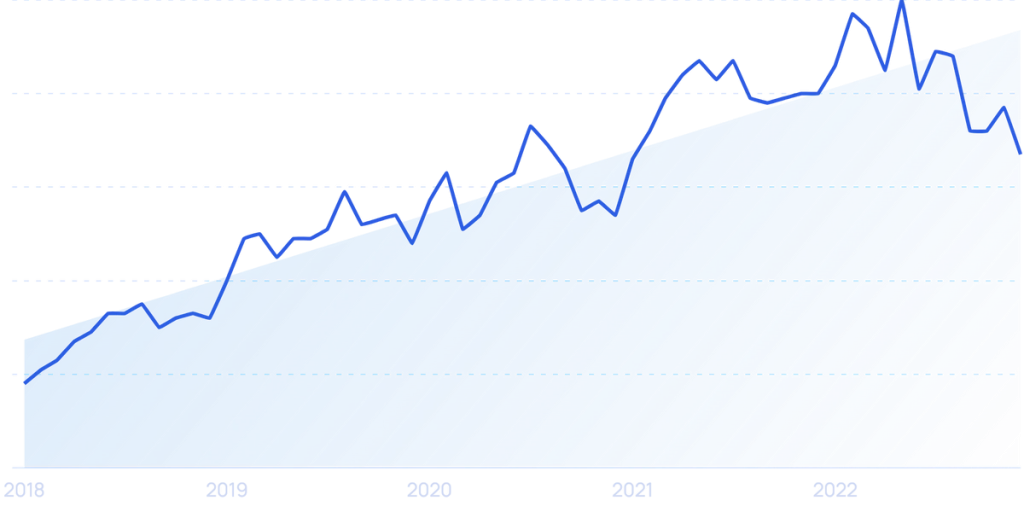
Car Retailer Searches
Over the past five years, there has been a 272% increase in searches for Car Retailer – “Carvana.”
5. Automotive Parts Market: Rapidly Growing With E-Commerce
Over the previous 20 years, there has been a steady growth in the global market for automotive parts.
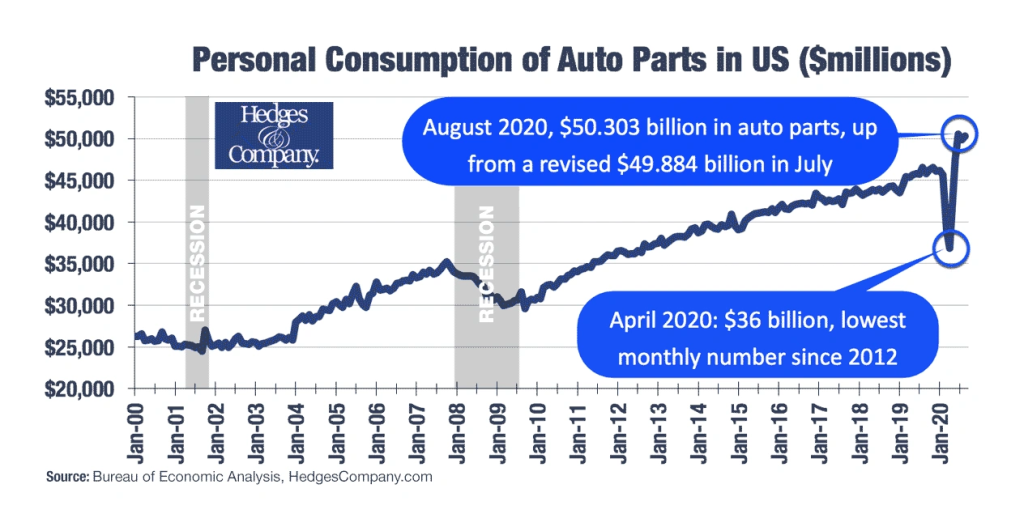
Automotive Parts Market Growth
And in 2021, sales in this sector reached about $723 billion.
The market for auto parts has completely changed as a result of ecommerce.
Nowadays, before buying a part, 94% of customers visit the manufacturer’s website to obtain product information.
Furthermore, the estimated value of the auto parts e-commerce sector is $19 billion.
The average age of vehicles on the road is rising, which is good news for the parts industry.
The rising quality of recently produced car parts, however, is also reducing the need for parts.
The sales of new trucks and light SUVs are largely responsible for this growth.
Sales of accessories and parts for this type of vehicle are more likely to increase.
6. Micromobility: Potential Choice Of Consumers
People have always preferred driving their own cars for transportation.
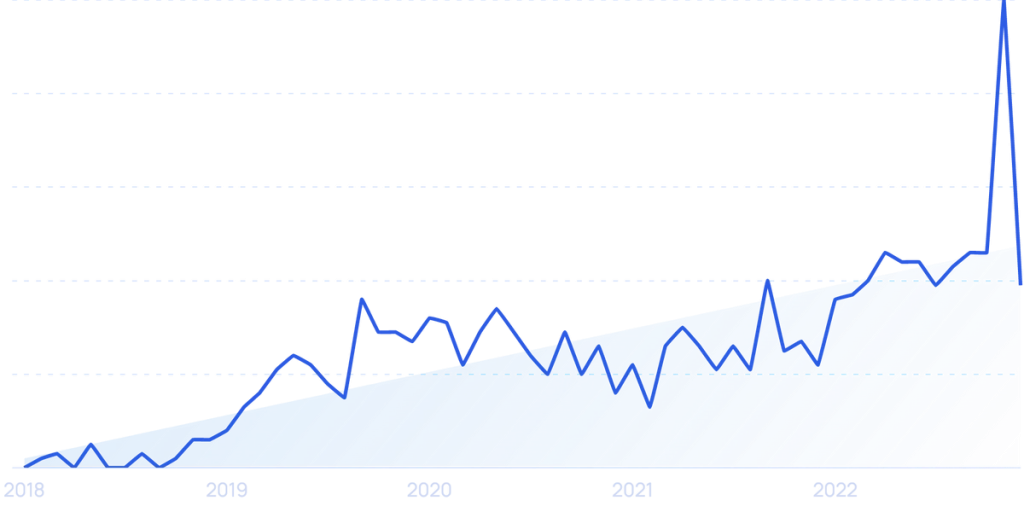
Micromobility Searches
“Micromobility” searches have become more frequent over the last five years.
Utilizing compact, slow-moving modes of transportation is known as micromobility. Mopeds, bikes, and scooters are a few examples, along with their electric counterparts.
In 2021, for instance, e-bike sales increased by 240%.
Electric scooter sales are also increasing. The US market, valued at $14 billion in 2021, is projected to increase at a compound annual growth rate (CAGR) of 10.7% to exceed $31 billion by 2028.
7. Hydrogen: The Future Fuel
Fuel cell electric vehicles (FCEVs) are an additional alternative to internal combustion engines in addition to battery-powered electric vehicles.
FCEVs function without a battery. Rather, they draw energy from a stack of fuel cells that are fed hydrogen and oxygen, which causes a chemical reaction that produces electricity. It functions similarly to a battery that doesn’t need to be recharged.
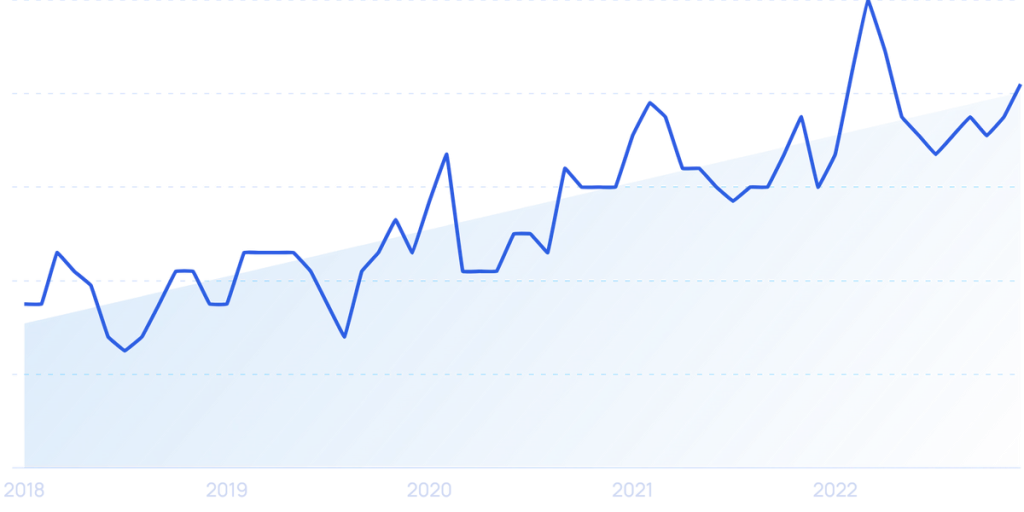
Hydrogen Fuel Searches
These cars emit no CO2; the only byproduct is water.
The ease of refuelling is an additional benefit. The process takes about five minutes and is akin to filling up a gas tank.
They can travel 300–400 miles on a single tank, which is comparable to that of gasoline engines.
Through 2026, the market for FCEVs is anticipated to expand at an astounding CAGR of almost 70%.
Let’s learn the best techniques to enhance sales in the automotive industry.
Top 8 Tactics To Boost Sales In Automotive Industry
Now that we have a grasp of the automotive sales industry’s meaning, let’s dive into some tactics that make it thrive:
1. Product Knowledge
In the automotive industry, product knowledge is paramount. Salespeople need to be well-versed in the features, specifications, and benefits of the vehicles they sell. Customers expect knowledgeable guidance when making such a significant purchase.
2. Building Trust
Establishing trust is a fundamental tactic among all the car dealer sales tricks. Customers want to know that they are choosing the best option available to them. Building trust requires integrity, openness, and honesty.
3. Effective Communication
Strong communication skills are a must for salespeople. They should actively listen to customers’ needs and preferences, and then tailor their sales pitch accordingly. Clear and concise communication is key.
4. Offering Test Drives
Allowing customers to test drive a vehicle is one of the most effective tactics. It provides a hands-on experience that can sway their decision.
5. Leveraging Technology
Embracing technology is crucial in the modern automotive sales industry. Online listings, virtual tours, and customer relationship management (CRM) software can enhance the sales process.
6. Competitive Pricing
Offering competitive and transparent pricing is vital. In a digital age where customers can easily compare prices, being fair and reasonable is a winning tactic.
7. After-Sales Services
Providing excellent after-sales services, such as maintenance, warranty, and support, can set a dealership apart from its competitors.
8. Customer Relationship Management
Building lasting relationships with customers is valuable for repeat business and word-of-mouth referrals. A well-maintained customer database can help with this.
Conclusion
The automotive sales industry is a multifaceted, dynamic sector that thrives on continuous innovation and customer satisfaction.
By understanding its meaning and adopting effective sales tactics, car dealerships and salespeople can navigate the challenges and capitalize on the opportunities in this competitive industry.
Whether you’re in the market for a new car or considering a career in automotive sales, these insights can help you make informed decisions and drive success in the industry.
Want to elevate your automotive sales skills to new heights? Discover our Automotive Sales Training Programs and drive your success forward.
HAPPY AUTOMOTIVE SALES!!!!
How can I start a career in automotive sales?
To start a career in automotive sales, you can apply for sales positions at dealerships, gain relevant product knowledge, and develop your sales skills through sales training and experience.
What is the impact of online sales on the automotive industry?
Online sales have expanded the reach of dealerships, allowing customers to research, configure, and purchase vehicles online. It has also increased competition and forced traditional dealerships to adapt.
How do manufacturers influence the automotive sales industry?
Manufacturers influence the industry by producing vehicles, setting prices, and providing marketing support to their dealerships.
What is the future of the automotive sales industry?
The industry is evolving with advancements in electric and autonomous vehicles, and it will continue to adapt to changing consumer preferences and technological innovations.
